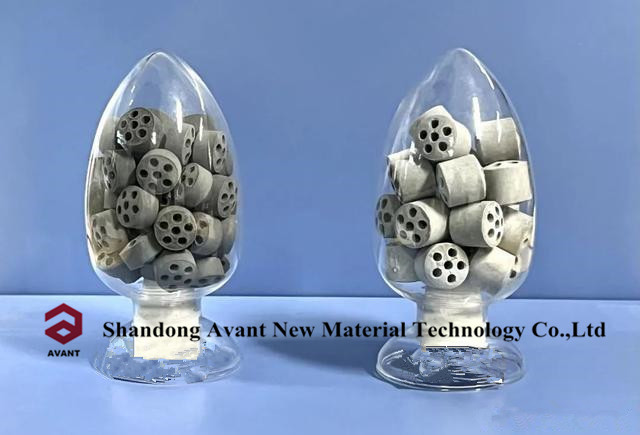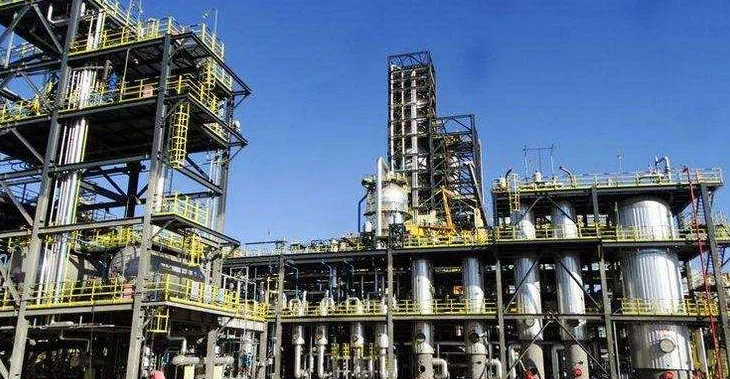Steam reforming catalyst is nikel oxide catalyst on alpha alumina carrier or calcium aluminate carrier.
The shape of 4-hole cylinder with dome provides it with large external geometric surface area,higher porosity,lower pressure drop and better gas flow distribution
AM-2-412Q/AM-2-413Q steam reforming catalysts are suitable for the steam reforming process of producing hydrogen,methanol synthesis gas and ammonia synthesis gas from natural gas.
AM-2-412Q steam reforming catalyst is installed in the upper half of the reformer tube, AM-2-413Q steam reforming catalyst is installed in the lower half of the reformer tube.
AM-2-412Q/AM-2-413Q steam reforming catalysts have the characteristics of large geometric surface, low bulk density, good heat transfer effect, high catalyst activity, low bed resistance and high operating flexibility.

AM-2-301/AM-2-302 steam reforming catalysts are suitable for the steam reforming process of producing hydrogen, methanol synthesis gas and ammonia synthesis gas from various refinery dry gas, natural gas, propane,etc.
AM-2-301steam reforming catalyst is installed in the upper half of the reformer tube, AM-2-302 steam reforming catalyst is installed in the lower half of the reformer tube.
AM-2-301/AM-2-302 steam reforming catalysts have the characteristics of large geometric surface, low bulk density, good heat transfer effect, high catalyst activity, low bed resistance and high operating flexibility.
Steam reforming process:
Application: Main industrial hydrogen production process, used in ammonia synthesis, methanol synthesis, iron ore reduction and hydrorefining of petroleum
Features: The reaction is strongly endothermic and limited by chemical equilibrium
Requirements: In order to achieve high conversion or yield, high temperature (700-1000°C) is required
Problem: The biggest problem with nickel at this temperature is sintering deactivation
But activity is not a problem because kinetic velocity at high temperature is sufficient
Because the positive reaction is strongly endothermic, heat transfer control is required
① Use thin reaction tubes (10-20 cm) to ensure sufficient heat transfer area, while requiring sufficient length to ensure proper space velocity (>10000 hr-1)
② Lower pressure drop with larger particles
③ Small pipe diameter, there are flow distribution problems, pipe diameter / particle size > 5-10
④ When the temperature is high, the speed is fast, and the effective selection factor is small
⑤ Selection of annular shape: not only ensures the void ratio of the bed, but also reduces the effective radius
⑥ Weighing some other factors, particle size = about 2 cm is appropriate
Because the forward reaction temperature is high, the catalyst needs to have good thermal stability
① Requires particles to maintain their physicochemical properties under reaction conditions
② To avoid phase changes and fragmentation
③ Appropriate high melting point materials are required as carriers, such as MgAl2O4, CaAl2O4

Methanation process:
Application: Remove trace CO in ammonia feed and CO in city gas, and synthetic natural gas
Features: The reaction is very exothermic
Requirement: Low temperature for favorable equilibrium yield (300-500°C)
Problem: Activity becomes a challenge due to low temperature
Catalyst used:
① Highly dispersed active component nickel
② Sophisticated preparation techniques to ensure fine-grained metallic nickel particles
③ High metal surface area must be effectively maintained at high temperatures - sintering must be limited
④ Catalyst, process and reactor design must be tailored to the needs of the process - it has been suggested that fluidized, entrained, circulating bed would be more suitable
Compare the two processes:
Sulfur poisoning:
① For steam reforming, this catalyst can tolerate higher sulfur levels due to the high enough temperature that steam removes sulfur
② For methanation, sulfur poisoning is irreversible, only deep desulfurization of the feed can protect the catalyst
Carbon deposition:
① For both processes, carbon deposits have serious consequences
② For steam reforming, the coke deposits are mainly from methane cracking
③ For methanation, the coke deposits are mainly derived from the disproportionation of carbon monoxide
④ In order to accelerate the gasification of carbon, potassium is often added, at the cost of reducing the activity
Catalyst Type | AM-2-412Q | AM-2-413Q | |
Form | Four-hole convex cylindrical | Four-hole convex cylindrical | |
Size mm | Length | 8~10 | 15~17 |
Outer diameter | 16 | 16 | |
Inner diameter ×hole No. | 4×4 | 4×4 | |
Bulk density,Kg/L | 0.90~1.05 | 0.90~1.05 | |
Radial crushing strength,N/Grain | ≥200 | ≥300 | |
Active component | 13±1% | 13±1% | |
Loading position | Upper half of the reformer tube | Lower half of the reformer tube | |
Catalyst Type | AM-2-301 | AM-2-302 | |
Form | Light black Four-hole convex cylindrical | Gray green Four-hole convex cylindrical | |
Size mm | Length | 8~10 | 15~17 |
Outer diameter | 16 | 16 | |
Inner diameter ×hole No. | 4×4 | 4×4 | |
Bulk density,Kg/L | 0.95~1.15 | 0.90~1.05 | |
Radial crushing strength,N/Grain | ≥200 | ≥300 | |
Active component | Ni O≥16 | Ni O≥10 | |
Active Agent | K2O≥2 | —— | |
Loading position | Upper half of the reformer tube | Lower half of the reformer tube | |